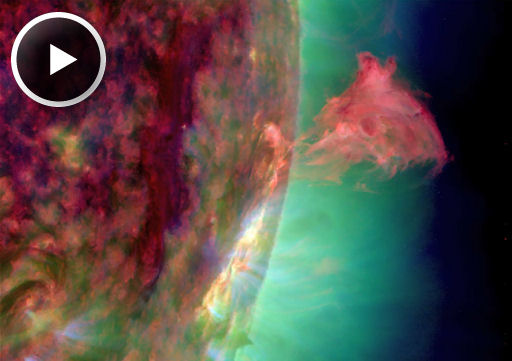MARS-DIRECTED CME: A minor CME that left the sun during the late hours of April 28th is heading for Mars. En route, it will sweep past the Mars Science Lab spacecraft, which is carrying Curiosity to the Red Planet. According to a forecast track prepared by analysts at the GSFC, the cloud will reach the rover on May 4th. Fortunately, Curiosity is equipped to sense and study solar storms: video.
THWARTED ESCAPE: Solar activity is low, with only a smattering of minor C-class flares coming from a few 'active regions' scattered across the solar disk. An eruption from sunspot AR1465 on April 29th didn't even get off the ground. NASA's Solar Dynamics Observatory recorded the thwarted escape:
It was AR1465 vs. gravity, and gravity won.
Solar activity should remain low for the next 24 to 48 hours, with no more than a 1% chance of X-class solar flares. As the movie above shows, however, even a weak eruption on the sun is worth watching. Stay tuned for more. Solar flare alerts: text, voice.
more images: from Alan Friedman of Buffalo, NY; from John Stetson of Falmouth, Maine

![]()
Solar wind
speed: 314.5 km/sec
density: 0.2 protons/cm3
explanation | more data
Updated: Today at 1636 UT
![]()
X-ray Solar Flares
6-hr max: C6 1041 UT Apr30
24-hr: C6 1041 UT Apr30
explanation | more data
Updated: Today at: 1600 UT
![]()
![]()
![]()
Daily Sun: 30 Apr 12
![]()
![]()
New sunspot 1472 appeared on April 29th. Credit: SDO/HMI
![]()
![]()
![]()
Sunspot number: 114
What is the sunspot number?
Updated 29 Apr 2012
Spotless Days
Current Stretch: 0 days
2012 total: 0 days (0%)
2011 total: 2 days (<1%)
2010 total: 51 days (14%)
2009 total: 260 days (71%)
Since 2004: 821 days
Typical Solar Min: 486 days
Updated 29 Apr 2012
The Radio Sun
10.7 cm flux: 116 sfu
explanation | more data
Updated 29 Apr 2012
![]()
![]()
![]()
Current Auroral Oval:
![]()
Switch to: Europe, USA, New Zealand, Antarctica
Credit: NOAA/POES
![]()
![]()
![]()
Planetary K-index
Now: Kp= 0 quiet
24-hr max: Kp= 1 quiet
explanation | more data
![]()
Interplanetary Mag. Field
Btotal: 3.7 nT
Bz: 1.3 nT south
explanation | more data
Updated: Today at 1636 UT
![]()
![]()
![]()
Coronal Holes: 30 Apr 12
![]()
![]()
There are no large coronal holes on the Earthside of the sun. Credit: SDO/AIA.





